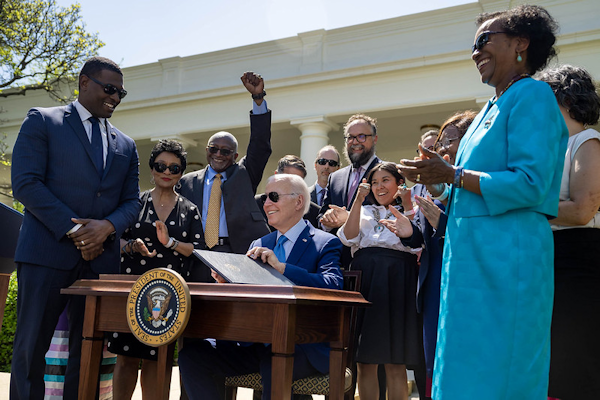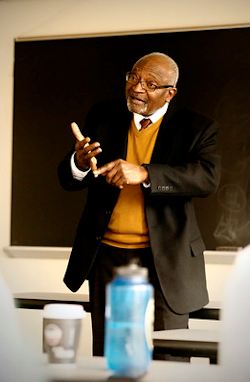SEJournal Online is the digital news magazine of the Society of Environmental Journalists. Learn more about SEJournal Online, including submission, subscription and advertising information.
 |
 |
| President Joe Biden at the Rose Garden signing ceremony for the executive order to launch the Justice40 initiative on April 21, 2023. Photo: White House Photo/Adam Schultz via Flickr Creative Commons (United States government work). |
Voices of Environmental Justice: Future of Justice40 Program Hangs in Balance
By Yessenia Funes
 |
Robert Bullard, deemed “the father of environmental justice,” has seen plenty of presidential administrations come and go since he began researching environmental racism back in the 1970s.
But he’s never seen race, class and identity take such a central role in environmental policy as they have under President Joe Biden.
“For the first time in my four-plus decades of working on environmental and climate justice issues, this is the first time that there was a framing that talked about targeting benefits, resources and investments toward those communities that historically have been left out and left behind,” Bullard told me. He continues his work at Texas Southern University in Houston, as well as on the White House Environmental Justice Advisory Council.
On that front, the president’s Justice40 Initiative has set an entirely new standard, as the federal commitment to allocate 40% of federal investments in climate, housing, clean energy and more toward disadvantaged communities that have been plagued by overpollution.
The program has transformed
the way communities and
grassroots organizations
tap into federal dollars.
The program’s rollout hasn’t been perfect since the White House first announced it in 2021, but it has transformed the way communities and grassroots organizations tap into federal dollars.
However, with a presidential election just weeks away, the future of Justice40 hangs in the balance.
Donald Trump has been clear in his stance to expand fossil fuel production. He’s also emphasized his disdain for diversity, equity and inclusion efforts.
Vice President Kamala Harris, meanwhile, has stood beside Biden’s efforts and has long championed efforts to bring clean air, water and land to Black and Brown communities. She’s received endorsements from the movement’s leaders, too.
As we prepare for a new president, journalists need to keep a close eye on Justice40.
What is Justice40?
The initiative to ensure 40% of federal dollars flow toward historically disinvested communities is now a part of 16 federal agencies, covering a total of 518 programs.
 |
| Robert Bullard, often referred to as “the father of environmental justice.” Photo: University of Michigan via Flickr Creative Commons (CC BY 2.0). |
Justice40 began with an executive order Biden signed during his first week in office. The order clearly targeted specific environmental issues: transit, housing, water infrastructure, clean energy, workforce development and toxic pollution.
By November 2023, the government had its list of programs where Justice40 was being implemented. Now, federal engagement with local communities has become a requirement when allocating dollars, a practice that didn’t exist before.
Biden’s landmark climate law, the Inflation Reduction Act, provided new opportunities to tap into federal funding — from grants to tax credits — but many of the communities Justice40 aims to reach don’t have the resources, knowledge or bandwidth to apply for federal dollars.
To ensure this time around goes differently, the U.S. Environmental Protection Agency established the Environmental Justice Thriving Communities Technical Assistance Centers Program, better known as TCTACs (pronounced like the candy), so that local organizations have somewhere they can bring their questions and receive help writing grants.
Justice40 has funneled $16 billion toward historically Black universities and colleges. The initiative has pushed federal agencies, such as the EPA and the Department of Energy, to prioritize communities of color and low-income communities when awarding federal grants.
Through the IRA, the White House has launched several grant programs focused on solar energy expansion, local clean air proposals and more. Without Justice40, agencies wouldn’t have been required to give 40% of those awards to disadvantaged communities.
“These programs are desperately needed to green our school buses,” Bullard told me, as well as improve infrastructure and support Black farmers.
As a Solutions Journalism Network climate fellow, I’ve spent the last year focused on highlighting different programs that have received federal funding through the IRA and are focused on bringing climate resiliency and clean energy into communities of color. There are so many success stories with organizations and groups that are expanding in ways that would’ve been impossible without Justice40’s spotlight on them.
Still, the initiative has seen its set of challenges. Indeed, those obstacles are part of the story, too — regardless of the results of November’s elections.
What has Justice40 missed?
Change doesn’t happen overnight. The type of change needed can’t happen in a single administration.
“When you look at the vastness of the problems that have been ignored for centuries, it is a good start, but it’s not good enough,” Bullard said of Justice40.
He’s not alone in that feeling. After all, money can only do so much when there’s a growing culture among the Republican Party to ignore race and history.
Some Republican-led states have been hostile to Justice40, explained Colleen Callahan, co-executive director of the Luskin Center for Innovation at the University of California, Los Angeles, who has studied the initiative and its impacts. The initiative’s full spectrum of benefits may not be felt in states that don’t believe in the concept of equity or reparations — but the needs remain.
“There’s a recognition that there’s only so much that the president can control with this initiative,” Callahan told me.
Justice40 also doesn’t actively factor race into its definition of “disadvantaged communities.” As a report from environmental nonprofit Resources for the Future makes clear, race is “possibly the most important factor,” so its exclusion severely limits Justice40’s ability to reach those who need its benefits the most.
On top of all that, there’s no real concerted effort to track these dollars, their rollout or their influence. That type of research requires money, and the IRA didn’t put much funding toward evaluating the impact of Justice40 or its hundreds of programs.
It’s important for the government
to take a step back and reflect on
how it can improve, especially for
an initiative as novel as Justice40.
It’s important for the federal government to take a step back and reflect on how it can improve, especially for an initiative as novel as Justice40. Bullard is especially concerned about how these dollars are going toward controversial infrastructure projects, such as highway expansion or carbon capture and storage plants that help perpetuate the lifespan of the fossil fuel industry.
These infrastructure proposals are receiving federal dollars from the IRA, so they also count toward Justice40’s goals — even if they’re perpetuating harm.
No federal program will be perfect the first time around, yet grand expectations surround Justice40. The stakes are high.
What is the future of Justice40?
First thing first: Every executive order can be reversed. That makes Justice40 especially vulnerable to a potential President Trump. However, the Biden administration has been crafty in ensuring the initiative touches everything, which makes it more difficult to dismantle.
If a Trump presidency, however, redirects federal agencies in an entirely new direction, which is likely, then all the processes and staff changes that have allowed Justice40 to flourish may be lost. The number of agency employees could be reduced, which would slow down their ability to issue grants and awards to communities.
As for those federal dollars that have already been paid out, they would be much harder, if not impossible, to take back. And Congress is the governing body behind a lot of Justice40’s resources, so a new president couldn’t dissolve it all with the flick of a pen, said Richard Moore, co-chair of the White House Environmental Justice Advisory Council and co-coordinator and founding member of Los Jardines Institute, an Albuquerque-based organization focused on economic and environmental justice.
That’s why Moore has been concentrating on organizing at the local level so that cities, counties and states can take advantage of these federal dollars while they’re available. In 2023, Albuquerque became the first city whose mayor signed a local executive order focused on Justice40.
“What we’re attempting to do is to really lock it in at the local level,” Moore told me. “How can we lock in particular things like Justice40 … so that every time a new administration comes in, we’re not fighting that battle over and over and over again?”
These local coalitions and efforts are part of the story — so are the solutions and the communities that have tapped into these dollars to create change. Justice40 has created a historic opportunity for groups and the people they represent. Their accomplishments deserve to be celebrated.
“We believe that journalists should be looking at those success stories,” Moore said.
If you’re interested in digging into this topic in more detail, here are some quick resources:
- Resources for the Future 2024 Report: “Implementation of Justice40: Challenges, Opportunities, and a Status Update”
- Climate and Economic Justice Screening Tool: You can use this federal tool to identify communities experiencing burdens in climate change, energy, health, housing, pollution, transportation and more.
[Editor’s Note: For more on the subject, check out our Topics on the Beat page on environmental justice, which includes nearly three dozen helpful stories from SEJournal, along with recent news headlines from EJToday.]
Yessenia Funes is an environmental journalist who has covered the justice beat for a decade. She publishes a creative climate newsletter called Possibilities. Funes has written for publications like Atmos, Vogue, Vox, New York magazine, The Guardian and more. Her approach to storytelling amplifies the voices of those on the frontline of our present-day ecological crises. Her reporting has taken her to remote Indigenous communities in Nicaragua, the hostile desert of the American Southwest and post-Hurricane Maria Puerto Rico.
* From the weekly news magazine SEJournal Online, Vol. 9, No. 38. Content from each new issue of SEJournal Online is available to the public via the SEJournal Online main page. Subscribe to the e-newsletter here. And see past issues of the SEJournal archived here.













 Advertisement
Advertisement 



